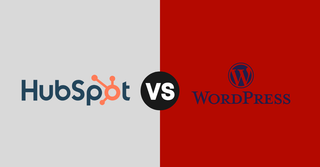HubSpot vs WordPress: which one is better?
Over twenty years have passed since its launch in 2003, yet WordPress remains one of the most widely used CMS platforms worldwide. However, the landscape is evolving. In recent years (especially the last couple of years), many users have faced increasing challenges with WordPress, leading to a heated competition for the title of the "best" CMS: HubSpot vs. WordPress.

Many developers and marketers have already migrated to this trending new platform, but why? Is it truly as good as people claim? In this article, we’ll dive into the data, share real experiences, and uncover the reality behind this battle.
Their history: WordPress vs. HubSpot
WordPress and HubSpot sound familiar to all, but do you know their stories? In this section, we will compare how and when both platforms were created and give you a hint of their basic technical aspects.
WordPress
On the one hand, there's probably the most well-known CMS: WordPress. A CMS created more than 20 years ago that has always been the king among all. WordPress was launched in 2003 by Matt Mullenweg and Mike Little as an open-source project based on b2/cafelog, a previous blogging software. Over the years, it has evolved into the most widely used content management system, powering over 40% of websites worldwide. Its flexibility, vast plugin ecosystem, and strong community support have made it the go-to choice for businesses, bloggers, and developers alike.

Regarding its cost, WordPress is a 100% free open-source software, one of the main reasons people love it. However, while the core software is free, users must pay for web hosting, premium themes, plugins, security features, and maintenance services, which can add up depending on the website’s complexity and needs as they are not included. Some people see this as a pro as they have more “flexibility” to use whatever tool they want to for hosting or security reasons, but others don’t.
HubSpot
On the other hand, there’s HubSpot, a not-so-newbie in the CMS world, as it was launched in 2006. Founded by Brian Halligan and Dharmesh Shah, HubSpot started as an inbound marketing platform before expanding its suite of services to include a CMS. Unlike WordPress, which is open-source and self-hosted, HubSpot CMS is a SaaS designed for marketers who seek seamless integration with CRM and automation tools. Its focus on ease of use, built-in SEO, and marketing tools makes it a strong competitor for businesses looking for an all-in-one digital growth solution.
Compared to WordPress, HubSpot has a Freemium pricing model and, therefore, has its limitations if you choose the free tire plan. The free subscription includes basic CMS features, but advanced functionalities (such as premium themes, A/B testing, custom reporting, and enhanced SEO tools) are only available in paid plans. Since HubSpot is an all-in-one hosted solution, users pay a subscription fee that covers hosting, security, and built-in marketing tools, making it a potentially higher-cost option compared to WordPress.
However, while WordPress has traditionally been the preferred option in the HubSpot vs. WordPress debate, that doesn't necessarily mean it's the best choice for every user. Many people gravitate toward WordPress simply because of its widespread recognition and long-standing reputation. However, HubSpot's CMS offers unique advantages, such as built-in marketing automation, advanced analytics, and native CRM integration. These are features that WordPress requires third-party plugins to achieve and that can overload your site and therefore affect SEO. But before rushing into those aspects, let's explore what they have to offer in terms of technical features.
Regarding technical features: HubSpot vs. WordPress
We have already talked about this in some of our articles, but this might be one of the main reasons why professionals are moving to HubSpot recently.
Even though WordPress was built as an SEO-friendly platform, there are some technical features that cause common problems that are going to drive you insane. For example, issues related with the sitemap due to URLs configuration, the incorporation of canonical tags that can sometimes be misconfigured, leading to duplicate content issues, or the challenge of managing page speed due to the heavy reliance on plugins. Additionally, WordPress users often struggle with maintaining an optimal site structure, as the flexibility of the platform can sometimes result in poorly organized URLs or conflicting SEO settings.
Another frequent headache is dealing with outdated or conflicting plugins, which can break essential SEO functions or slow down the website significantly. Security vulnerabilities are also a concern, as WordPress sites require constant updates and proper configuration to prevent attacks that could negatively impact search rankings.
While WordPress offers powerful SEO capabilities, these technical issues can become a major obstacle if not handled correctly, and HubSpot is designed to eliminate many of these common headaches by offering a more streamlined, built-in approach to SEO. Unlike WordPress, which relies heavily on third-party plugins for optimization, HubSpot’s CMS comes with integrated SEO tools that simplify on-page optimization, keyword recommendations, and site performance monitoring.
One of HubSpot’s biggest advantages is its automatic sitemap generation and structured URL configuration, reducing the risk of errors that commonly occur when using WordPress. Additionally, HubSpot handles canonical tags correctly by default, preventing duplicate content issues without requiring you to edit them manually.
Another standout feature is its fast and secure hosting environment. Since HubSpot CMS is a fully managed platform, users don’t have to worry about plugin conflicts, security vulnerabilities, or performance issues caused by bloated themes. Page speed and mobile responsiveness are optimized out of the box, which can significantly boost SEO rankings without additional technical effort.
In the following table, you can see more visually the technical features comparison.
| Feature | HubSpot | WordPress |
|---|---|---|
| SEO Optimization | Built-in SEO tools with on-page optimization and keyword recommendations. | Requires third-party plugins. |
| Sitemap management | Automatic sitemap generation with structured URL configuration. | It can have issues due to URL configuration. |
| Canonical tags | Handled correctly by default to prevent duplicate content. | It can be misconfigured, leading to duplicate content issues. |
| Page speed | Optimized out of the box for fast loading speeds as it uses modern technologies like CDN by Cloudflare among other cloud service providers. | Affected by heavy reliance on plugins and themes. |
| Site structure | A structured approach ensures better organization. | Flexible but can result in poorly organized URLs and conflicting settings. |
| Plugin dependency | No need for external plugins; everything is built-in. | Requires multiple plugins for SEO, security, and performance optimization. |
| Security | Fully managed hosting with strong security measures. | Requires constant updates and proper configuration to prevent vulnerabilities. |
| Hosting environment | Fully managed, secured, and optimized hosting. | Depends on external hosting providers, leading to variable performance. |
| Customization and flexibility | Still highly customizable, but more limited than WordPress. | Highly customizable but relies on plugins and themes that con overload the site. |
| Integration and automation | Seamlessly integrates with HubSpot’s marketing, sales, and CRM tools. | Requires third-party integrations for marketing and CRM |
| Multilanguage support | Offers built-in multilingual support with an SEO-optimized structure. | Relies on third-party plugins that don’t work well and make WordPress more weak regarding security and site structure among other things like Polylang or WPML (we hate it). |
For now, it seems there’s a clear winner, but let’s continue comparing HubSpot vs. WordPress.
Regarding SEO: HubSpot vs WordPress
Technical aspects are closely tied to SEO, as we explained in the previous section. Now, let’s compare HubSpot and WordPress in terms of rankings and SEO optimization.
SEO tools
As mentioned before, WordPress relies on third-party plugins to integrate tools into your interface, and the same applies to SEO tools. To optimize your site, you'll need to download plugins like RankMath or Yoast (some of which are downright ineffective). In contrast, HubSpot has its own built-in SEO tool.

This AI- and machine-learning-powered SEO tool helps you optimize your entire site, from landing pages to blog posts, by providing content suggestions, SEO recommendations, and real-time insights. Additionally, it shows keyword performance, measures ROI, suggests internal linking strategies, and ensures your site follows best practices, without the need for extra plugins.
Image optimization
Another critical factor for SEO and site performance is image optimization. WordPress does not offer built-in image compression, forcing users to install third-party plugins like Smush or ShortPixel to reduce file sizes. On the other hand, HubSpot automatically optimizes images, compressing them without losing quality and ensuring faster load times, without the need for additional tools.
Page speed
Those long load times bring us to another major downside of WordPress: speed. Page speed is a crucial ranking factor, and WordPress sites often suffer from slow loading times due to excessive plugins, heavy themes, and unoptimized databases, among other things. If not properly maintained, these factors can drastically reduce site performance.

HubSpot, however, is a fully managed platform with optimized servers, built-in caching, and a lightweight structure that ensures fast loading speeds without requiring extra configurations. Furthermore, while HubSpot delivers images via a CDN (Content Delivery Network), which further reduces server load, improves scalability, and minimizes errors, WordPress users have to pay for this service.
URL structure
A clean and logical URL structure is essential for SEO, and WordPress has never been an ally in this matter. Its default URLs are not SEO-friendly (e.g., ?p=123), and users must manually adjust permalinks to improve readability. Additionally, managing redirects requires plugins (yes, another one…), which can create unnecessary complications.
In contrast, HubSpot automatically generates clean, SEO-optimized URLs and provides built-in redirect management, making it easier to maintain a well-structured site.
Indexing
If search engines struggle to crawl your site, then HOW ARE YOU GOING TO APPEAR ON GOOGLE? WordPress sites often face indexing issues due to poorly coded themes, excessive JavaScript, or incorrect robots.txt settings, forcing site owners to manually index their pages (even though some SEO plugins offer sitemap generation, yes, another plugin).

HubSpot, on the other hand, ensures automatic sitemap generation, proper indexing settings, and seamless integration with Google Search Console, reducing the risk of crawl errors.
Content optimization
We say this ALL THE TIME: creating high-quality content is the most important thing for SEO. But content optimization is just as crucial, and WordPress doesn't provide native tools to help with it. Instead, users must rely on plugins for readability analysis, keyword recommendations, and structured data.
HubSpot’s built-in SEO tool, however, offers real-time content suggestions, readability scores, and topic clustering to improve rankings. Additionally, HubSpot’s content strategy tool helps you plan and structure pillar pages, enhancing overall site authority. You can also use our free SEO Analyzer tool to evaluate your site's SEO performance regardless of which platform you choose.
Responsiveness
You’re probably reading this article on your phone. And if not, you already know that people are relying more on their phones and less on their computers. Google knows that, too. That’s why the search giant now prioritizes mobile-first indexing, making a responsive website non-negotiable.

While many WordPress themes claim to be mobile-friendly, some require extra CSS adjustments or additional plugins to ensure a seamless mobile experience. HubSpot’s templates and design system, however, are fully responsive by default, ensuring that your site adapts perfectly to any device without extra effort.
When it comes to SEO, WordPress can be optimized, but it requires multiple plugins, regular maintenance, and technical expertise to keep everything running smoothly.
HubSpot, on the other hand, provides a hassle-free alternative with built-in SEO tools, automatic optimizations, and an intuitive interface, helping businesses improve their rankings without the headache of plugin overload.
Regarding UX: HubSpot vs WordPress
We have discussed their history, technical aspects, tools, and how they interact with SEO, but what about the user experience? We have little to say in favor of WordPress, as its interface is anything but intuitive. WordPress hasn't significantly updated its platform since its release (20 years ago!), and this becomes evident when users try to make changes, often forcing website owners who want to edit or improve their site to hire a developer to fix everything.
However, even developers face challenges. Despite being familiar with WordPress, the platform's interface is not easy to navigate, leading to additional costs due to developers' hourly rates.
HubSpot's team, recognizing this issue with WordPress, developed a more intuitive interface that is continuously improving based on user feedback. For developers working with HubSpot CMS, tools like our HubSpot DevTools browser extension make debugging and development even smoother with quick access to debug mode, cache busting, and HubL documentation. Additionally, the HubSpot blog is full of resources to help users not only create their site through this CMS but also optimize it with SEO, design tips, and more. In contrast, WordPress users often have to rely on forums to troubleshoot issues, making HubSpot the better alternative.
Which one is better?
After this in-depth comparison, we think you might already know our answer, but in case you still have doubts: HubSpot is better than WordPress. Why? Well, we have listed plenty of reasons why you should opt for HubSpot when choosing a CMS: its ease of use for website owners, greater SEO-friendliness compared to WordPress, and fewer technical issues. HubSpot is now the king of CMS, and if you're still on WordPress, WHAT ARE YOU STILL DOING THERE? Stop wasting time and money. We warned you!